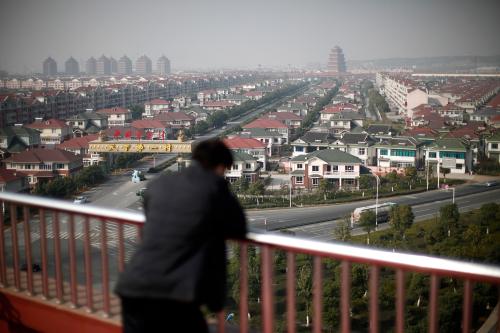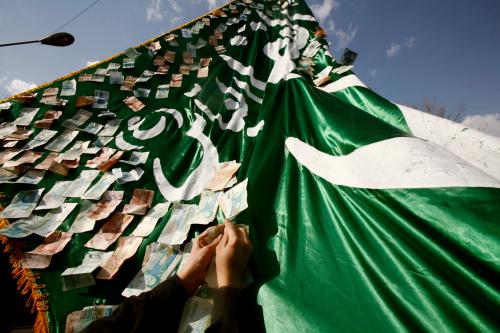This week the U.S. and Iranian negotiators met for indirect talks in Vienna and agreed on procedures for the two countries to return to the 2015 Iran nuclear deal, formally known as the Joint Comprehensive Plan of Action (JCPOA). Millions of Iranians continue to suffer economically from both U.S. maximum pressure sanctions and the pandemic. Meanwhile, the Biden administration has been waiting for Iran to get back into compliance before it considers easing the sanctions. A dozen op-eds and bipartisan congressional letters have urged President Biden to keep his predecessor’s maximum pressure campaign going, using the damage done to the livelihood of millions of Iranians as leverage to extract more concessions.
The delay in patching up the broken nuclear agreement is not due merely to difficulty in choreographing who does what first. There is a belief that sanctions soften Iran’s negotiating position. This belief, for which there has been little evidence, is a misreading of the deal’s history. What brought Iran to the negotiating table in 2013 was not the economic distress caused by the Obama administration’s sanctions, rather it was a popular desire on the part of Iran’s middle class for economic improvement through access to the global economy, if not through better relations with the West.
A decade of economic stagnation caused by sanctions and broken international promises has brought Iran’s middle class to a point that it may reconsider its future as a force for political moderation and globalization.
In 2013, with strong middle-class support, President Hassan Rouhani was elected to negotiate a nuclear accord with the U.S., a key demand of the electorate. His victory was not borne of economic distress but of hope. While Obama’s sanctions influenced the election agenda, they did not drive the outcome. Within months of the imposition of sanctions, the value of Iran’s currency collapsed, unleashing inflation that undermined the gains in the living standards of ordinary Iranians, including the middle class. But sanctions alone would not have produced the nuclear accord, as much harsher sanctions under Trump have amply demonstrated.
A decade of economic stagnation caused by sanctions and broken international promises has brought Iran’s middle class to a point that it may reconsider its future as a force for political moderation and globalization. What the Biden and Rouhani teams accomplish in Vienna in the coming weeks may determine that future.
The rise of Iran’s middle class
In the 15 years before the 2011 Obama sanctions, sustained economic growth doubled GDP per capita and lifted millions out of poverty and into the middle class. This transformation was the product of market-based reforms after the end of the war with Iraq, rural-biased public investment in infrastructure, education, and health, and rising oil prices in the 2000s.
During the same period, survey data show that average living standards in urban areas, home to the middle class, more than doubled. According to a widely accepted income threshold (per capita expenditures above $11 PPP, or twice the World Bank poverty line of $5.5 for upper-middle-income countries), during this period the middle class grew rapidly from 28 percent to 60 percent of the population, the majority rising from the ranks of the poor, whose share dropped from 33 percent to 7 percent. (The lower-middle class dropped from 38 to 32 percent and the upper-income group doubled its share from 1 to 2 percent.)
Electoral power
As the largest social class with the most education, Iran’s middle class is a strong voting group. In 1997, when Iran elected its first moderate and pro-rapprochement president, Mohammad Khatami, the middle class accounted for only 30.5 percent of the population and 56.1 percent of the educated population of voting age (older than 16 and with at least a high school education). By 2011, they had doubled their share of the population to 59.8 percent and of educated voters to 80.9 percent.
Rouhani’s election in 2013 benefited significantly from support of the middle class who were energized by his promise to end the sanctions and repair relations with the West. He won in the first round against six other candidates with 51 percent of the votes. Four years later, after he had signed the nuclear agreement and the economy had bounced back while sanctions briefly eased in 2016, Rouhani was reelected in a landslide. He won 57 percent of the votes against his rival, Ebrahim Raisi, the current powerful chief of the judiciary. In the prosperous middle-class subdistrict of northern Tehran (Shemiranat), Rouhani’s vote share jumped from 49 percent in 2013 to 79 percent in 2017, signifying his rising popularity with the middle class.
Sanctions and the JCPOA
Obama’s sanctions helped make the nuclear deal happen because it offered a peaceful path to an economy the middle class was familiar with and in which it had prospered. They also helped by demonstrating to the middle class the fragility of Iran’s global links, and the need for Iran to limit its nuclear ambitions for access to the global economy. Sanctions worked because the overall policy did not aim for regime change and did not pit Iran’s middle class against the country’s leadership and its powerful security forces.
In contrast, Donald Trump and his secretary of state, Mike Pompeo, demanded surrender and talked often of regime change. They invited Iranians to participate in overthrowing their government without assuring them how Iran would come out any better than the other countries in the region where similar radical change had taken place. Iran’s middle class was not interested because it had its hands full managing life during the economic and health crises. In fall 2018, when protests erupted following energy price hikes, the middle class in Tehran and other larger cities was noticeably absent.
The future of the middle class
Biden’s foreign policy claims to serve the middle class—the U.S. middle class, that is. But it should look farther and wider to the middle classes in developing countries, especially those in the Middle East. Middle classes are often thought of as anchors of democratic values, but these values do not thrive in hard economic times. As John Maynard Keynes famously warned in 1919, economic distress can easily tip the scale in favor of authoritarian rulers who offer economic security.
Iran’s middle class has been on an economic roller coaster since 2011. Negative and positive growth years have followed each other, mostly as sanctions have intensified or eased. Last year real average per capita expenditures were back where they were in 2001, before the oil boom. Since 2011, the middle class has shrunk by about 8 million people.
A poll taken in early 2021 indicates that economic hardship has changed the outlook of Iranians away from support for moderate politicians and globalization. Support for the JCPOA is down from about 80 percent when it was first signed to 50 percent now. A majority believed that their government should wait for the U.S. to remove sanctions before talking to Biden. The poll also showed declining popularity for President Rouhani and his administration. Only 1 in 3 view him favorably compared to 3 in 4 for Ebrahim Raisi, whom he had soundly defeated in 2017. The most popular Rouhani Cabinet member, Foreign Minister Javad Zarif, is also viewed less favorably than Raisi.
Given that the JCPOA will not be back up and running by this June when Iran elects a new president, it is likely that conservatives will dominate all branches of government in the coming years. This will make Biden’s task of returning to the JCPOA and extending it more difficult. However, as hard as it is for the U.S. to shelve its favorite sanctions tool, from a long-term perspective it would do well to stop using Iran’s middle class as leverage to pressure the Iranian government.
The Brookings Institution is committed to quality, independence, and impact.
We are supported by a diverse array of funders. In line with our values and policies, each Brookings publication represents the sole views of its author(s).







Commentary
Iran’s middle class and the nuclear deal
April 8, 2021